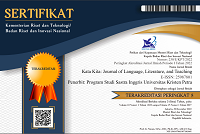COMMUNICATION STRATEGIES OF HIGH AND LOW ACHIEVERS: A CASE STUDY
DOI:
https://doi.org/10.9744/katakita.4.1.7-12Keywords:
schedule assessment, penjadwalan, penilaian, PMI, GAO, DCMA, dan NDIA.Abstract
This study is about communication strategies used by high and low achievers when they were doing the role plays in X elementary school. This study is to find out two research questions about the types of communication strategies and the differences and similarities in their use by high and low achievers. In order to answer the research questions, the writer uses Brown’s communication strategies (2007) as the main theory and Littlewood’s (1984) as the supporting theory. There are three findings: First, the high achievers used nine types of communication strategies and the low achievers used seven types of communication strategies. Second, the high achievers used a lot of different types of communication strategies, but their frequency of using them was lower than the low achievers. On the other hand, the low achievers used fewer types of communication strategies, but their frequency of using them was higher than the high achievers.
References
BusyTeacher. (2015). 262 free role playing games worksheets. Retrieved August 20, 2015, from http://busyteacher.org/classroom_activities-speaking/roleplays/
Brown, H. D. (1994). Principles of language learning and teaching (3rded.). New Jersey: Prentice Hall Regents
Brown, H. D. (2007). Principles of language learning and teaching (5thed.). New York: Pearson Education.
Littlewood, W. (1984). Foreign and second language learning: Language acquisition research and its implications for the classroom. Cambridge: Cambridge University Press.
The report: English program of X school. (2015). Surabaya: X elementary school.
Downloads
Issue
Section
License
Authors who publish with this journal agree to the following terms:- Authors retain copyright and grant the journal right of first publication with the work simultaneously licensed under a Creative Commons Attribution License that allows others to share the work with an acknowledgement of the work's authorship and initial publication in this journal.
- Authors are able to enter into separate, additional contractual arrangements for the non-exclusive distribution of the journal's published version of the work (e.g., post it to an institutional repository or publish it in a book), with an acknowledgement of its initial publication in this journal.
- Authors are permitted and encouraged to post their work online (e.g., in institutional repositories or on their website) prior to and during the submission process, as it can lead to productive exchanges, as well as earlier and greater citation of published work (See The Effect of Open Access).














